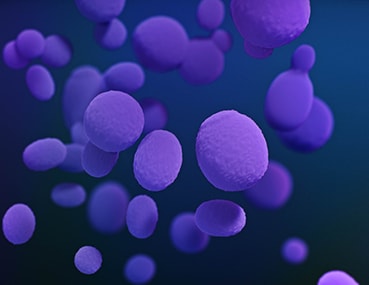Antimicrobial Resistance in Candida

Medical illustration of Candida spp., presented in CDC’s Antibiotic Resistance Threats in the United States, 2019.
Antimicrobial resistance happens when germs like bacteria and fungi develop the ability to defeat the drugs designed to kill them. That means the germs are not killed and continue to grow. Antimicrobial resistance is an increasing problem with the fungus Candida, a yeast. Candida infections may resist antifungal drugs, making them difficult to treat.
About 7% of all Candida blood samples tested at CDC are resistant to the antifungal drug fluconazole. Although one Candida species, Candida albicans, is the most common cause of severe Candida infections, resistance is most common in other species, particularly Candida auris, Candida glabrata, and Candida parapsilosis.1
Resistance to another class of antifungal drugs, echinocandins, is particularly concerning. Echinocandin resistance appears to be increasing, especially in the species Candida glabrata. C. glabrata already has high levels of resistance to the antifungal fluconazole, and this resistance has remained fairly constant over the past 20 years, according to CDC surveillance data.1 Echinocandins are the preferred treatment for C. glabrata, and echinocandin resistance could severely limit treatment options for patients with candidiasis caused by C. glabrata.
Patients with Candida infections that are resistant to both fluconazole and echinocandin drugs have very few treatment options. The primary treatment option is amphotericin B, a drug that can be toxic for patients who are already very sick. Growing evidence suggests that patients who have antimicrobial-resistant Candida bloodstream infections (also known as candidemia) are less likely to survive than patients who have candidemia that can be treated by antifungal drugs.2,3
Concern is rising over the emerging fungus Candida auris,4 which is rare in most areas of the United States but is a growing threat. Resistance rates for C. auris are much higher than for other Candida species:
- About 90% of U.S. C. auris samples are resistant to fluconazole
- Up to one-third are resistant to the antifungal drug amphotericin B.5
Although most C. auris samples are susceptible to echinocandins, resistance to echinocandin drugs can also develop while the patient is being treated with these types of drugs. Moreover, C. auris is a concerning public health issue, especially because it can be difficult to identify with standard laboratory methods and spreads easily in healthcare settings, such as hospitals and long-term care facilities with patients who have high care needs.
- Toda M, Williams SR, Berkow EL, Farley MM, Harrison LH, Bonner L, et al. Population-based active surveillance for culture-confirmed candidemia — four sites, United States, 2012–2016. MMWR Surveill Summ 2019;68:1–15.
- Alexander BD, Johnson MD, Pfeiffer CD, Jiménez-Ortigosa C, Catania J, Booker R, et al. Increasing echinocandin resistance in Candida glabrata: clinical failure correlates with presence of FKS mutations and elevated minimum inhibitory concentrations. Clin Infect Dis 2013;56:1724–32 Jun 15
- Baddley JW, Patel M, Bhavnani SM, Moser SA, Andes DR. Association of fluconazole pharmacodynamics with mortality in patients with candidemia. Antimicrob Agents Chemother 2008;52:3022–8
- Satoh K, Makimura K, Hasumi Y, Nishiyama Y, Uchida K, Yamaguchi H. Candida auris nov., a novel ascomycetous yeast isolated from the external ear canal of an inpatient in a Japanese hospital. Microbiol Immunol 2009;53:41–4.
- Lockhart SR, Etienne KA, Vallabhaneni S, Farooqi J, Chowdhary A, Govender NP, et al. Simultaneous emergence of multidrug-resistant Candida auris on 3 continents confirmed by whole-genome sequencing and epidemiological analyses. Clin Infect Dis 2017;64:134–40.